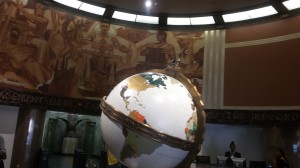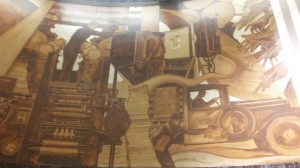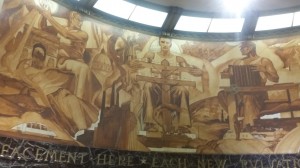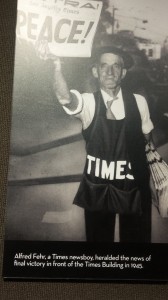THE LOS ANGELES TIMES (PART 1)
THE LOS ANGELES TIMES (PART 1)
By Charles N. Stevens
Photos by Dolores Seidman
Most of us are familiar with the Los Angeles Times Building, that solid concrete structure located at the corner of First St. and Spring in downtown Los Angeles. It is not a beautiful building, but its art deco lines are distinctive. It has been part of the downtown Los Angeles scene since 1935.Its fortress-like appearance contrasts to the Times former building constructed of red bricks. That building suffered extensive damage when a bomb placed by the Union blew up in 1910.
We were lucky enough to tour the old building as The Los Angeles Times is moving to a brand new facility on Imperial Boulevard in El Segundo. The paper will have a new owner, Patrick Soon-Shiong, said to be a visionary, who may give the Times more life.
Upon entering the Times Building we were impressed with its dazzling rotunda. In the center was a giant globe of the world with all of its countries clearly outlined and named. Higher up around the curvature of the room were sepia-toned paintings depicting Los Angeles history and the giants of the paper. Off to the side of the rotunda were large photographs related to the growth of the newspaper and some of its leaders, Colonel Otis and the Chandlers. Most interesting were a series of front page headlines highlighting important events such as the fire and destruction of the Hindenburg , the D-Day invasion, VJ Day and that OJ was found not guilty.
We were fortunate to have an excellent tour guide, Darrell Kunitomi, who gracefully entertained and informed over 70 people crowded into the rotunda. We gathered around an old linotype press. Words typed on its keyboard appeared on lead plates. These ancient machines are no longer used. We could imagine the klickity clack of the machines when the paper was about to go to press.
Out of the rotunda now, we walked through long hallways adorned by famous photographs taken by Times photographers. The photos were so stunning that most of us wanted to spend more time gazing at them, but we had to move on. We passed “posters” showing Pulitzer Prizes won by the Times. Interesting too was a glass-fronted display case holding all the various cameras used or once used by The Times photographers.
Elevators whisked us to the upper floors where the writing and research is done. We looked out on a sea of low cubicles in a large space, many of them empty of workers. Some writers and reporters were on assignment at various places, but the Times, like most newspapers, have had to cut back on staff. In movies we always see the newspaper offices as a bee hive of activity with people hurrying everywhere. What we saw was quiet and calm with just a very few people sitting before computer screens or talking on the telephone.
Some of the above lack of activity is due to the imminent move to El Segundo. Notices taped to the walls urge the workers to clean out their drawers and throw away all that they can. There is an aura of sadness in the place, especially for those who have worked there for many years in this hallowed building. We could detect this feeling in our guide who had worked in this building for over 40 years, the place being a part of his life.
We moved on through other rooms of cubicles, pausing at the glass-enclosed test kitchen where many of the recipes that used to be printed in the Times Food Section were tested. A few people were in the kitchen, but apparently they were just cleaning up. How I wished the Food Section would again appear in the Times!
Hungry after all our standing and walking, we arrived at the cafeteria where we could grab a bite to eat before boarding our bus for the second part of our tour to where the paper is actually printed—about 30 minutes away, near the intersection of Olympic and Alameda. More about this next time.

The rotunda af the L.A. Times building features a large globe of the world and sepia paintings around the walls.

The paintings on the wall feature "modern" civilization .

Note the mascularity of the workers and the "ultra modern" car in additional paintings.

The newsboy holds up one of the famous Times headlines- The End of World War II.
MONTEREY PARK AUTHOR PUBLISHES 4th BOOK – Seeking More of the Sky: Growing Up in the 1930’s:
Charles “Norm” Stevens, a 43 year resident of Monterey Park has recently published his 4th book: Seeking More of the Sky: Growing Up in the 1930’s. This is the story of a young boy growing up in Inglewood, California in the l930’s. This was a time during the depression when unemployment was affecting many and the banks were closed, while the clouds of war were gathering in Europe. But he was lucky enough to be raised in a loving family, the power of that love reflected throughout his stories.
Stevens is the author of three previous books about his experiences during WWII:
An Innocent at Polebrook: A Memoir of an 8th Air Force Bombardier (Story of his 34 bombing missions from his base at Polebrook, England over Germany and France)
The Innocent Cadet: Becoming A World War II Bombardier (A prequel to the first, telling of his training in the U.S. before going overseas into combat.)
Back from Combat: A WWII Bombardier Faces His Military Future from Combat: (This book details the time from when he returned from combat in England until the end of the war.)
He is known to the readers of The Citizen’s Voice as the author of Travel Log Articles including “Cruising the Rhine and Mosel”,” Best of the West”, “In Search of Snow” , “From Paris to Normandy on the Seine”, and “Exploring New York”. He is retired, having taught for 32 years, primarily in the Montebello Unified School District.
Those interested in purchasing an autographed copy of any of his books, may contact the author at 323-721-8230 or Normstevens24@gmail.com.



